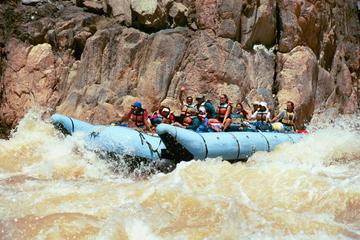What in essence would be a controlled flood is being proposed for the Colorado River through Grand Canyon National Park.
The end goal is to see whether high water can rebuild the river's beaches and sandbars.
Of course, such an experiment was conducted back in 1996 and again in 2004, when the results were not very satisfying. This time around, though, Interior Department scientists say they should have greater success because there's more sand in the river corridor now than there was previously.
Currently, scientists say sand supplies in the river are at a 10-year high with a volume about three times greater than the volume available in 2004 due to tributary inflows below the dam over the past 16 months.
Before the gates at Glen Canyon Dam can be opened, though, the U.S. Bureau of Reclamation must prepare an environmental assessment on the plan. This document should be ready for public review sometime next month. A decision by the Interior Department is anticipated in late February, with plans to conduct the high flow in early March if the decision is to move forward with the experiment.
“The proposed 2008 high-flow experiment and the accompanying studies build on learning that occurred as the result of the experiments in 1996 and 2004,” says John Hamill, chief of the U.S. Geological Survey's Grand Canyon Monitoring and Research Center. “Given the current amount of sand in the system, we have a tremendous opportunity to learn more about whether high flows can be used to improve important natural, cultural, and recreational resources in Glen and Grand canyons.”
According to a press release from the park, one of the proposed studies will document habitat changes and determine how backwater habitats are used by young humpback chub and other native and nonnative fishes. Other studies will look at how higher flows affect the aquatic food base, rainbow trout recruitment and emigration, riparian vegetation, nonnative fishes and archaeological resources in close proximity to the Colorado River.
During the proposed high-flow experiment, the Bureau of Reclamation will release water from both the power plant and the bypass tubes to a maximum amount of approximately 41,000 cubic feet per second for about 60 hours. If approved, current plans would call for the flows to begin increasing on March 4 with power plant bypass flows to begin on March. If a decision is made to move ahead with the experiment, a final release schedule will then be announced.
Since 1996, releases from Glen Canyon Dam have generally ranged between 8,000 and 20,000 cfs. The increase to 41,000 cfs will change river conditions as well as the availability of campsites. It is suggested that all river users be prepared for variable conditions, including higher river flows.
"The water released during the test will not change the amount of water to be released over the course of the 2008 water year,” said Larry Walkoviak, regional director of the bureau's Upper Colorado Region. “The current plan of operations calls for releasing 8.23 million acre-feet of water from Glen Canyon Dam. That water flows downriver to Lake Mead for use by the Lower Colorado River Basin States and Mexico. The experimental flows are included within this annual volume. Monthly releases later in the year will be adjusted downward to account for the water released during the experiment.”
Grand Canyon rafters, fisherman and other river users and hikers can call Grand Canyon National Park’s River Permits Office at 1-800-959-9164 for additional information on how the high-flow event may affect their visit. You can find additional information at this site.




Comments
I have scheduled a fly-fishing trip with many out-of-state friends for March 27-30, 2008 (Lees Ferry). Should I cancel this trip?!?!?
Who's running these dams? NASA? First its bad, then it's good, then we destroy habitat, but discover endangered species living in the new habitat, but then we decided to 'restore' the habitat, but then we harass endangered species (did I mention exotic, endangered species?). At least if we're gonna do these things, can someone send me an invitation, I'd like to see one at least.